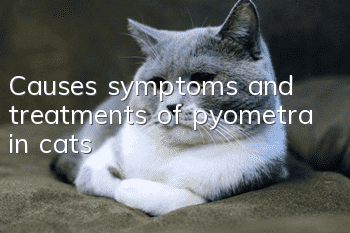Causes, symptoms and treatments of pyometra in cats

In fact, there are not many cases of pyometra in cats, because relatively speaking, the sterilization rate of cats in China is still relatively high, and sterilized cats can completely avoid the problem of pyometra, so generally uterine Cats with pyometra are mostly older female cats that have not been neutered. Severe pyometra can also be life-threatening for cats.
1. Cause:
If the ovaries function abnormally and secrete too much progesterone (progesterone), it can stimulate the growth and secretion of endometrial glands, which can cause fluid to accumulate in the uterine cavity and increase the uterine cavity. At the same time, progesterone can also counteract the contraction of uterine muscles, which also promotes the accumulation of fluid in the uterus. If secondary bacterial infection occurs at this stage, pus will form in the uterus, or if infection does not occur, clear uterine effusion will form. In addition, experimental studies have confirmed that exogenous hormone therapy, such as estrogen and progesterone, can also cause uterine effusion-pyometra. Therefore, caution must be exercised when using such hormones on unneutered female cats. Statistics from a foreign trap-neuter-return program for stray cats show that the incidence rate of pyometra is 0.4% (12/3000).
2. Symptoms:
1. The main symptoms of cats suffering from pyometra include vaginal discharge or no purulent secretions, sometimes with blood.
2. Increased abdominal circumference, usually manifested by anorexia and weight loss, and in severe cases vomiting symptoms.
3. The spirit is relatively poor. Due to the absorption of endotoxins in the body, the body is in a weak state.
4. Since the toxin also inhibits the hematopoietic function of the bone marrow, sick cats will also show severe anemia.
Diagnosis and treatment of pyometra in cats
Severe pyometra may endanger the cat’s life, so when a cat is found to have this disease, it must be treated as soon as possible. In order to avoid the occurrence of this disease, it is recommended that cats be sterilized after they have been bred once to avoid future problems. As for cats that are already sick, let’s take a look at the treatment methods.
Diagnosis:
Diagnosis is mainly based on blood routine, B-ultrasound, X-ray films, etc. Routine blood tests showed that the total number of white blood cells increased significantly, reaching more than 30,000, the number of neutrophils increased, and the nuclei shifted to the left.
Radiology: Uterine enlargement, no fetus.
B-ultrasound: There is a fluid dark area near the bladder, ruling out pregnancy.
Cytological examination of vaginal secretions: open type - a large number of pus cells; closed type: mediumThe interlayer contains nucleated epithelial cells, neutrophils, etc.
Treatment:
After a clear diagnosis is made, surgery is performed as soon as the animal's physical condition permits to remove the uterus and ovaries. If the anemia is severe, blood transfusion may be given before surgery to alleviate the anemia. For weaker animals, the acid-base balance and ion balance need to be corrected, and dehydration needs to be corrected. Due to the absorption of endotoxin, individual cases can also cause nephrotoxicity. Therefore, it is very important to adjust your body's condition before surgery. Another issue is anesthesia. Improper anesthesia can directly lead to death for weak animals. Therefore, inhalation anesthesia is the first choice for surgical anesthesia. Warming is also very important during surgery and the entire treatment process.
- Take two bites when the cat licks its fur
- Will a cat’s fever subside on its own after being neutered?
- There are transparent threads on the cat’s eyeballs
- Will cats definitely develop pyometra if they are not neutered?
- What should I do if my cat howls at night?
- How many times a month does a cat vomit hairballs?
- Why does a Siamese cat bite you more and more when it hits you?
- Will kittens get cold if the room temperature is 18°C?
- What is the reason why the kitten is so annoying?
- Why does a cat open its mouth to pant?



